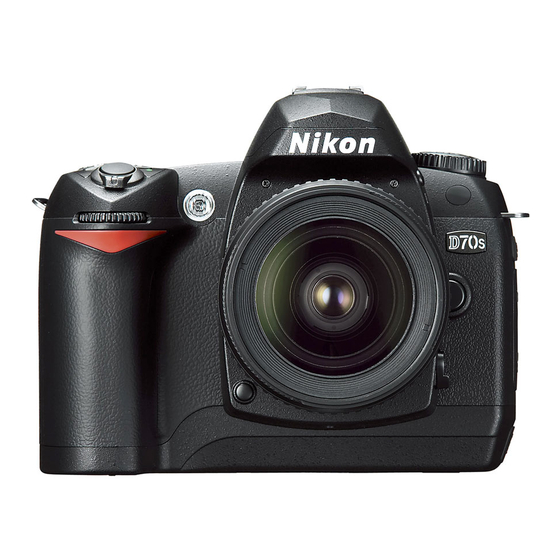
Nikon D70s Help Manual
Hide thumbs
Also See for D70s:
- Manual (219 pages) ,
- Repair manual (121 pages) ,
- Brochure & specs (9 pages)
Advertisement
Nikon D70s Help Guide
The camera settings shown below offer a starting point for taking pictures with the Nikon D70s digital camera.
Nikon includes a help manual with each camera. We encourage you to familiarize yourself
A
Recommended Camera Accessories
Nikon D70s Camera Body
Nikkor 60mm Micro Lens
Nikon SB-29s Ring Flash
128MB CompactFlash card
(multiple camera cards optional)
NOTE: We recommend that you use the 60mm lens as opposed to a more traditional 105mm lens because the camera has a built-in mag-
nification of 1.5x. A 60mm lens is equivalent to a 90mm lens on a 35mm camera. The normal 105mm lens that is recommended for use
with 35mm film cameras is too long. The user would have to take the photos from more than 7 feet away, and with the flash this far from
the patient's face, the images may be darker.
We recommend purchasing two CompactFlash cards and using a Card Reader to import images to the Quick Ceph program. Although the
camera can be connected directly to the computer using a USB cable, the transfer process would use the camera batteries unnecessarily
and would make the camera unavailable to take additional photos. Two cards allow the user to transfer images with one card while tak-
ing additional photographs with the other.
B
Camera Setup
Before taking photographs, the image size on the camera needs to be changed to
1
the Medium setting. This yields images with a resolution of 2240 x 1488 pixels,
which is sufficient for Quick Ceph 2000. To do this, click on the Menu
on the back of the camera. The menu will appear on the back LCD screen. Select
the "Shooting Menu"
the camera. Push the right arrow to view the options, then select "Image Size".
You can change the setting from the Large to Medium setting in this window.
Next, set the camera to the "Aperture Priority" mode by rotating the Function
2
Dial to the "A" mode.
The SB-29s ring flash should be mounted to the hot shoe on the top of the cam-
3
era, and the ring should be mounted on the lens. Depending on the lens size, you
may need to use a lens adapter to connect the flash to the lens. The ring flash bag
included with the SB-29s ring flash contains three different sized lens adapters to
allow you to mount the flash unit.
C
Tips for Taking Extraoral Images
When taking the extraoral images with the 60 mm lens, the camera should be held
1
approximately 5 feet from the patient's face. Set the aperture to "F11" by rotating
the Sub-Command Dial clockwise. If the F value does not appear, hold down the
shutter button half-way to display the F value. You can then change the F-stop value.
Hold down the Metering Selector button on the back of the camera and rotate the
2
Command Dial to select the "Matrix Metering"
The flash intensity of the SB-29s ring flash should be set to the highest manual
3
setting for the extraoral images. On the back of the Controller unit mounted on
the hot shoe, slide the Flash Mode Selector to the "M" mode, as shown on the
image to the right.
http://www.quickceph.com/docs/1028Nikon_D70_help.pdf
with the settings and usage of this camera.
using the Multi-Selector button, located on the back of
Sub-Command Dial
option, shown in the top LCD.
Quick Ceph Systems, Inc.
button
Multi-Selector Button
Page 1
®
Image Size Menu
Function Dial (A)
Lens Adapter
Metering Selector button
and Command Dial
SB-29s Flash Intensity on
Flash Mode Selector
Ideal settings for the extraoral
photographs, displayed on
top LCD screen.
Doc ID# 1028Nikon_D70_help - Revision 3-6-06
Advertisement
Table of Contents

Summary of Contents for Nikon D70s
-
Page 1: Camera Setup
Nikon D70s Help Guide ® The camera settings shown below offer a starting point for taking pictures with the Nikon D70s digital camera. Nikon includes a help manual with each camera. We encourage you to familiarize yourself with the settings and usage of this camera. - Page 2 The Nikon D70s equipped with a 60mm lens can be used to take digital images of x-rays that are 100% the size of the orig- inal when imported into QC2000. To do this, place the x-ray on a lightbox and situate the camera so that the distance between the lens and the x-ray is exactly 1015mm.















Need help?
Do you have a question about the D70s and is the answer not in the manual?
Questions and answers